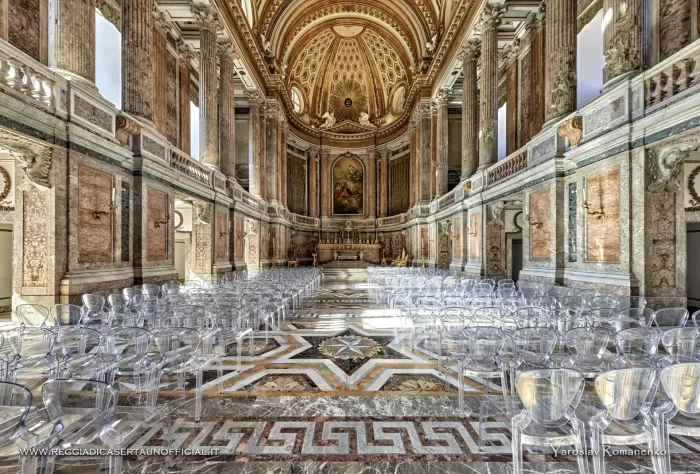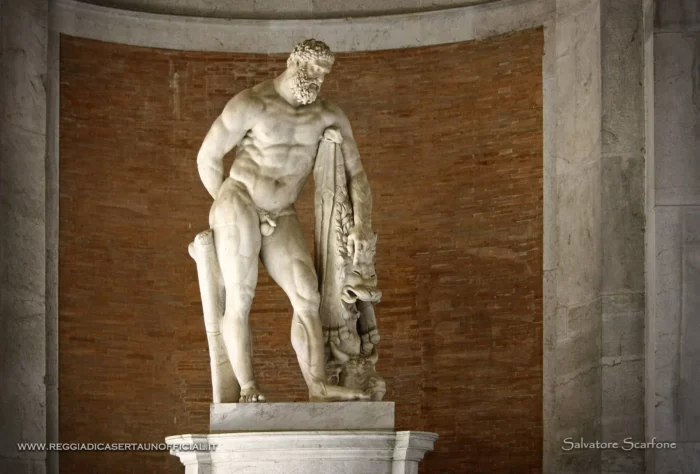The marbles and ancient sculptures in the Royal Palace of Caserta
Luigi Vanvitelli, thanks to his training and studies, had learned to appreciate the greatness of the ancients by admiring the magnificence of Roman buildings and ancient sculptures, with their marble decorations and their sumptuous ornaments. When Charles of Bourbon called him to design the Royal Palace of Caserta, Vanvitelli enriched the Palace not only with the best marbles of the Kingdom, but with a collection of ancient statuary and marbles.
The reuse of ancient marbles in the Royal Palace of Caserta
The impact that classical solutions had on the rendering of the royal palace of Caserta, beyond the sculptural decoration of the main facade which was never built, is evident in the myths translated into marble or fresco, in the numerous copies taken from the ancient present in the complex – and in particular we remember the four statues placed in the niches of the lower vestibule, created by Andrea Violani and Pietro Solari, representing Venus and Germanicus, Apollo and Antinous – and above all in the massive practice of reusing ancient materials.
The reason for such a considerable presence of ancient marbles in the Royal Palace of Caserta is determined by the fact that the royal factory was an important crossroads where materials arrived from all parts of the kingdom, acquired above all through repeated practices of spoliation to the detriment of the buildings of the past.
To the marbles quarried in the surroundings of Caserta were then added the many marbles of the Farnese Collection, inherited by Charles through a bequest from his mother Elisabetta Farnese, and transferred from Rome to the capital of the kingdom partly by him and then by his heir Ferdinand IV. They were insistently requested by Vanvitelli – who had personally seen them stacked in the warehouses of the Naples dock – since he believed he could reuse the less valuable ones in the floors and allocate the more valuable ones to the Chapel, a supreme dedication to God for which the king had ordered to spare no expense.
Finding himself reigning in a territory so rich in ancient finds, encouraged even by the requests of his first architect, Carlo behaved exactly like the rich clients of late antiquity who looked for precious marbles to quarry from ancient buildings and insert into new ones.
The ancient sculptures placed in the Vanvitellian complex
From the documents of the Historical Archive of the Royal Palace of Caserta and from the inventories it can be seen that at the Vanvitellian complex, together with the many architectural elements, a large number of ancient sculptures were introduced which should have contributed to giving splendor to the palace. Among these, the statue of Aphrodite of Capua stands out, today preserved in the National Archaeological Museum of Naples.
The warehouses of the palace must have been truly evocative environments. Mentioned several times in archive documents, they were rooms located on the ground floor, intended for the conservation of the many marbles that arrived here. They housed, between a plaster copy and a model to draw the work from, a large number of ancient statues, often dismembered, reliefs, epigraphs and colored marbles.
In addition to the statues acquired by the crown thanks to the excavations promoted in the kingdom and the deals concluded through the king’s trusted men, the Farnesian sculptures which arrived from Rome were introduced into the deposits, also called “sculpture warehouses”, also thanks to the decisive role of Luigi Vanvitelli . The latter, in continuity with the valorization policy experimented by Carlo already in 1751, imagined attracting the attention of “foreigners” to the new palace through the best pieces of the collection.

